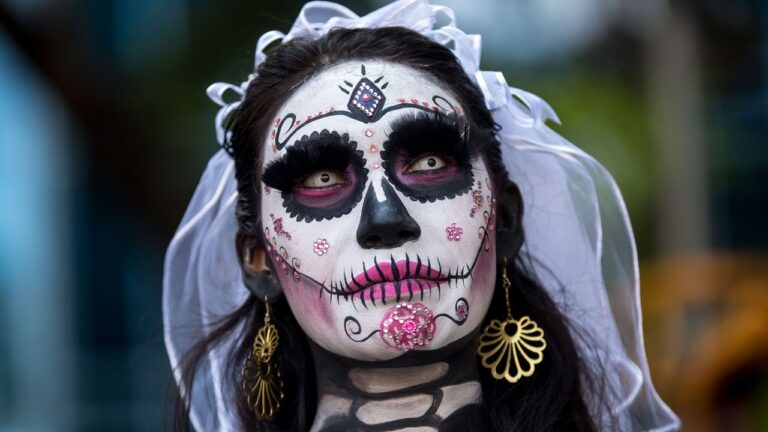
[ad_1]
A calaca is a skeleton, a calavera is a skull, and a calavera de azucar is a sugar skull (which is a frosted, skull-shaped treat made from sugar paste and decorated with colorful patterns). The most popular calavera of all is “La Calavera Catrina,” a high-society skeleton lady dressed in a fancy floral hat, from a 1910 etching by Mexican artist José Guadalupe Posada. The print was meant as political satire, showing that the tailored European clothes and snooty attitudes favored by upper-class indigenous Mexicans at the time didn’t matter — we’re all equal in death. She has become the most iconic symbol of Día de los Muertos. (Odds are you’re not doing sugar skull makeup; you’re actually painting your face like a Catrina.)
Additionally, the little details within your calavera makeup and the accessories you pair it with serve as subtle nods to your family’s own specific history. Latinx folks aren’t a monolith — every individual, family, and community celebrates differently. “Every detail in our catrinas represents a tradition we have had for generations,” says makeup artist and content creator Rosy McMichael. “The colorful strokes represent our rich culture, the specific accessories used remind us of our abuelitas, and the clothing could be from many eras. The catrina is a celebration, and these details represent that.”
What is calavera makeup supposed to look like?
Let’s dispel an all-too-frequent misconception and be clear on something: Calaveras are not supposed to be scary.
“I work with children at an after-school program in Los Angeles, and I’ve always celebrated Día de los Muertos with them. We’d go all out, and I’d face-paint my students. When I became the program coordinator, I made sure all of the kids joined in and learned the meaning of Día de los Muertos. I really wanted to differentiate it from Halloween — it’s not the same holiday,” says Bautista.
Some parents who weren’t familiar with the holiday were hesitant at first. “They said, ‘What’s going on? What are they doing over there, witchcraft?’ But it can help children with their fears. When the kids say, ‘That’s scary,’ I ask, ‘What about a skeleton is scary? You’re a skeleton and I’m a skeleton. We’re all skeletons. It’s just another phase of our lives to become skeletons.’ There’s nothing scary about that, and we shouldn’t make kids scared of it,” she says. “I think it’s romantic to dedicate a day to whoever you’re missing. Who wouldn’t want to partake in such a sweet holiday?”
So, how can you create your own makeup look for Día de los Muertos?
Tip 1: Avoid greasepaint from the Halloween store.
That’s for clowns, not calaveras. It’s gooey and never seems to set, so Bautista prefers water-based theatrical makeup. For foundation, she uses Mehron Paradise AQ foundation in white, which she activates with water and applies with a Kabuki brush (“Apply in a circular motion from the center of the face out,” she says). For drawing black lines, she uses a thin brush dipped in Wolfe Water Based Makeup. “After it sets, you can apply your usual makeup over it, which you can’t do with greasepaint,” says Bautista, who uses blush and eyeliner on her skeletal beauties, as well as gemstones, sequins, and cosmetic glitter stuck on with lash glue.
[ad_2]